Your cart is empty now.
Ever since the dawn of civilization in the country, several deities emerged on the Indian religious scene; while some of them vanished into oblivion as suddenly as they had mushroomed, some of them left an indelible impression in the minds of the people and are adored in one form or the other even during the modern times. Hanuman happens to be one such deity. Though scholars have tried to trace the presence of Hanuman in the Vedic literature in the form of Vrsakapi, the Brahma Purana, however, recognizes Vrsakapi to be none else than Hanuman himself. Hanuman, as such, however, was introduced by Valmiki for the first time in the Ramayana where initially he had an insignificant role as a minister of Sugriva. His personality got a great boost soon after he came in contact with Rama and Laksmana, the Ayodhya princes. In fact, most of the episodes in the Kiskindha, Sundara, and Yuddha Kandas of the Ramayana hover around Hanuman. There, he is presented as an excellent warrior, a devoted servant, a diplomat par excellence, a most intelligent person, and the one, who possesses all the virtues, and could render selfless service to one and all. He never had any aspirations of his own and his entire performance in the epic was dedicated to the service of others. He could perform such heroic deeds, which none else even Rama and Laksmana could do.
The work which indeed is of an encyclopaedic nature, highlights in considerable detail, the performance of Hanuman as spelled out in various texts as well as that projected in the Indian plastic art.
The author, a graduate of the Punjab University, served in a curatorial capacity in the Central Asian Antiquities Museum, New Delhi, the Archaeological Museum, Nalanda, and the Archaeological section of the Indian Museum, Calcutta for a number of years. He has to his credit the scientific documentation of over fifty thousand antiquities, in the museums, representing the rich cultural heritage of the country and comprising of sculptures, bronzes, terracottas, heads, seals and sealings, ancient Indian numismatics, woodwork, miniatures and paintings, textiles and Pearce collection of gems, ranging from earliest times to the late medieval period. He was awarded, in 1987 a Fellowship for his monograph on the Temples of Himachal Pradesh by the Indian Council of Historical Research, New Delhi. The glimpses of the author’s works are provided hereunder:-
(We bow to Hanuman who is the son of Maruta, the Wind god, a devotee of Rama, the brave among the Vanaras, the friend of Sugriva, destroyer of Lanka, the one who crossed the vast ocean, the remover of the agony of Sita by carrying the ring to Rama to her, who prescribed the death of Ravana and the one who is Paramatma).
In the early Vedic texts, there is a deity called Vrsakapi, who happened to be the friend of Indra and who rescued Indra from demonic bondage. The word Vrsakapi represents a monkey with the strength of Vrsa or a bull, or a huge monkey because Vrsa stands for a bull as well as for a creature of gigantic proportions. The reference to Vrsakapi in the Vedic literature is somewhat obscure but in the Brahma Purana the episode of Vrsakapi has been described somewhat elaborately; he is stated to have emerged out of the waters of Ganga, with tejas of Brahma, Visnu, and Siva. The same text identifies Vrsakapi of the Vedic literature with Mahakapi Hanuman of the epic and Puranic literature. The question here arises as to why should the Vedic Vrsakapi be adopted by the epics and the Puranas as Mahakapi or Hanuman. The tradition of Vrsa representing the bull was also not lost sight of, because in the Puranic account, there is a mention of Nandi, the chief gana of Siva, having the face of a monkey, whom Ravana despised, once on a visit to Kailasa. Nandi in return cursed him that monkeys would ultimately become the cause of his destruction. This indeed is not an isolated case because in the later developed form of Brahmanical deities, there had been a tendency to adopt the Vedic gods and deify them in the later developed faiths. For example, Rudra of the Vedic texts was later conceived to be Siva, and Vedic Prajapati as Brahma, of the Puranic literature. Even Visnu of the Vedic literature was adopted in the Puranas as a four-armed god having his usual attributes of conch, cakra, mace, and lotus. These attributes of Visnu are not present in the Vedic literature. Even with the emergence of Ganesa as the god for the removal of obstacles and the bestower of success, some Vedic hymns were associated with him and the performance of the related rituals. Therefore, it would not be surprising if Vrsakapi of the Vedic literature was adopted in some modified form as Mahakapi or Hanuman in the epics and the Puranic literature.
There has been a discussion as to whether Hanuman was actually a species of monkey or a human being. In this connection, attention is invited to the description of Hanuman as provided in the epics, Puranas, and other classical writers of the Brahmanical faith. They have used all the synonyms of monkey for Hanuman. There is also the mention of vanara-vamsa which has been interpreted to mean the dynasty of the vanaras or monkeys. The text also testifies that this vanara-vamsa was created by the gods who incarnated at the instance of Brahma, to help Rama in his fight with Ravana. This vanara-vamsa has been conceived to be a human race by the Jain texts. Taking, however, into consideration the immense strength, intellect, wisdom, command in speech, and other infallible virtues of Hanuman, one tends to believe him to be very much human. But while doing so, the tail possessed by Hanuman comes in the way, because no human can possess a tail. The tail is also not a symbolic one, because it was used not only by Hanuman but also by Angada and others for a variety of purposes. It is therefore quite difficult to arrive at a definite conclusion on this particular issue, which has still to be examined from a close angle.
| Chapter -1 | Introduction | 1-10 |
| Chapter -2 | Birth, Childhood, Education and Old Age | 11-28 |
| Chapter -3 | Literary Sources | 29-84 |
| Chapter -4 | Iconography | 85-105 |
| Chapter -5 | Art Forms | 106-117 |
| Chapter -6 | Plastic Art | 118-150 |
| Chapter -7 | Epigraphy, Numismatics, Seals and Sealings | 151-156 |
| Chapter -8 | Beyond Indian Frontiers | 157-182 |
| Chapter -9 | Multi-faceted Profile | 183-194 |
| Chapter -10 | Vedic Vrsakapi to Mahakapi Hanuman | 195-203 |
| Chapter -11 | Vanaravamsa | 204-216 |
| Chapter -12 | Adoration of Monkeys through the Ages | 217-221 |
| Chapter -13 | The Great Leap | 222-226 |
| Chapter -14 | Tantric Profile | 227-232 |
| Chapter -15 | The Medicinal Properties | 233-235 |
| Chapter -16 | The Vermillion | 236-237 |
| Chapter -17 | As a Cult Deity | 238-242 |
| Chapter -18 | Contribution of Tulasidasa; | 243-251 |
| Chapter -19 | The Devotion of Suradasa | 252-253 |
| Chapter -20 | The Exotic Eye | 254-257 |
| Chapter -21 | Evidence of Buddhist Texts | 258-262 |
| Chapter -22 | Pancamukhi- and Ekadasamukhi Hanuman | 263-269 |
| Chapter -23 | Epilogue | 270-273 |
| Bibliography | 275-286 | |
| Appendices | 287-382 | |
| Index | 383-389 | |
| Correlation of Text with Plates | 390-417 | |
| Illustrations and Plates |
SAMPLE PAGES
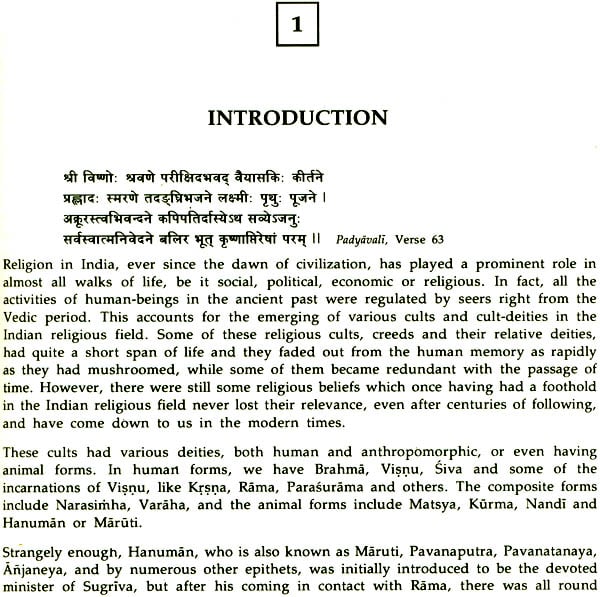
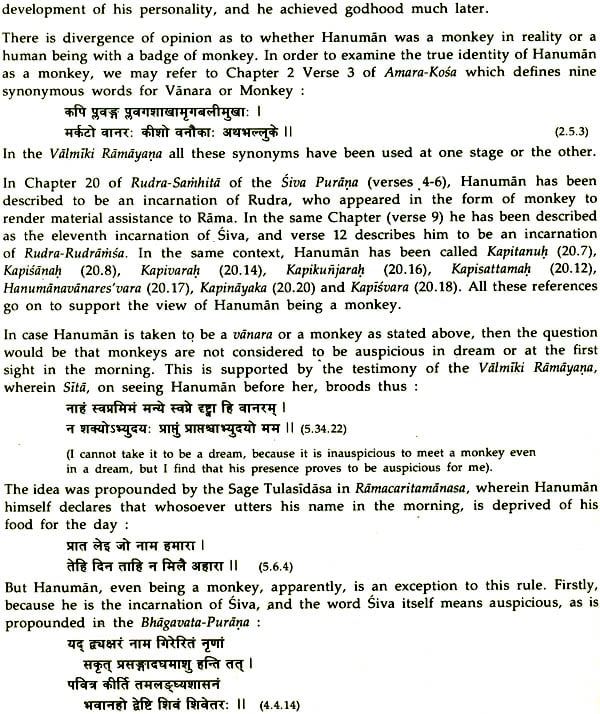
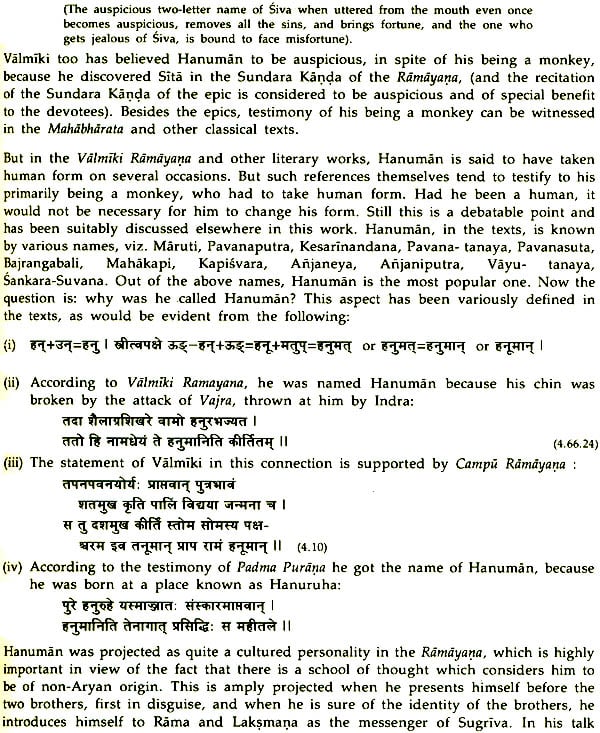
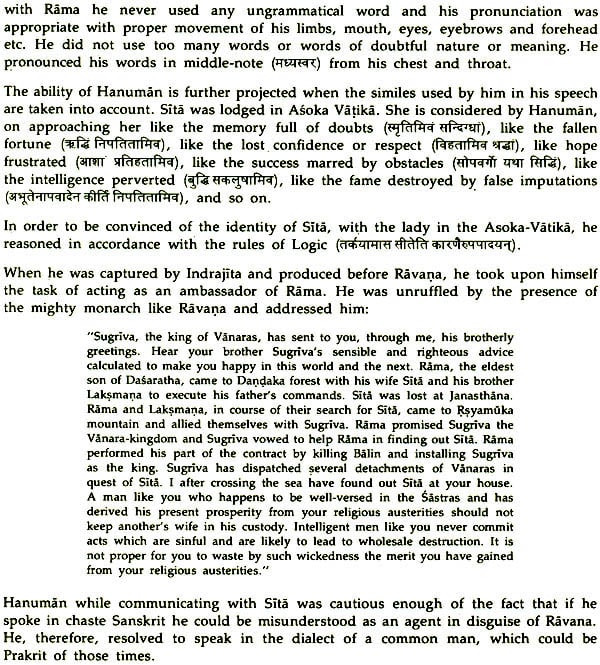
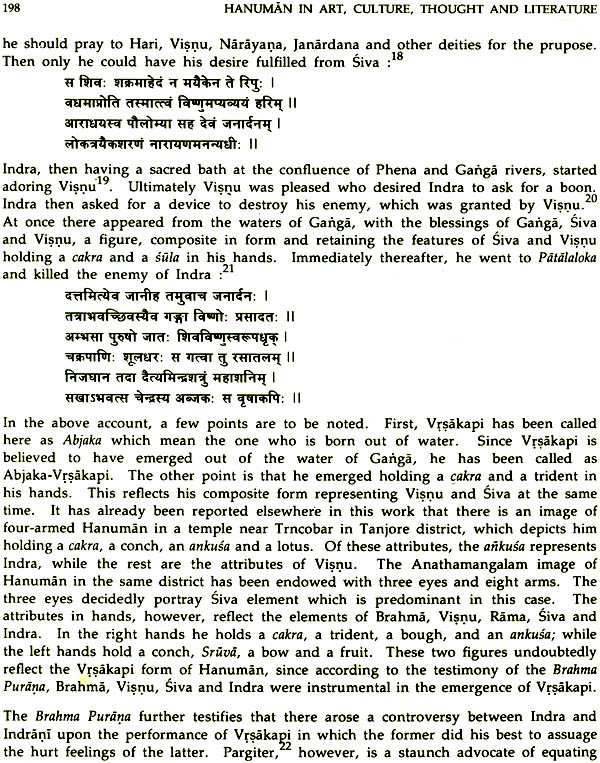
Delivery and Shipping Policy
- INTERNATIONAL SHIPPING
- Rs.1000-1100/kg
- ESTD. Delivery Time: 2-3 weeks (depending on location)
- Bubble Wrapped with Extra Padding
- NATIONAL SHIPPING
- NCR: Rs. 30/half kg
- Standard: Rs. 80/half kg
- Express shipments also available on Request
- ESTD. Delivery Time: Ranging from 1-4 days up to 7 business days (Depending on your choice of Delivery)
- TRACKING
- All orders; national or international, will be provided with a Tracking ID to check the status of their respective orders
- Depending on the Shipping Service, Tracking ID may be used on their respective tracking portals
Frequently Asked Questions (FAQs)
Domestic Shipping: 3-4 Days (after shipping)
International Shipping: 1-2 weeks (based on your location)
You will receive an email once your order has been shipped or you can email us if you didn't receive tracking details (info@mlbd.co.in)
Every book that we sell is the latest edition except all the rare books
Yes, we do provide free shipping, only on domestic orders (within India) above Rs.1500






![Advaita Vedanta mein Gyan evam Bhakri : Darshnik Vimarsha [Knowledge and Devotion in Advaita Vedanta : Philosophical Discourse] by Dr. Satyakam Mishra and Dr Karan Sigh](http://www.motilalbanarsidass.com/cdn/shop/products/ADVAITAVEDANTAMEGYAN_large.jpg?v=1675408211)




